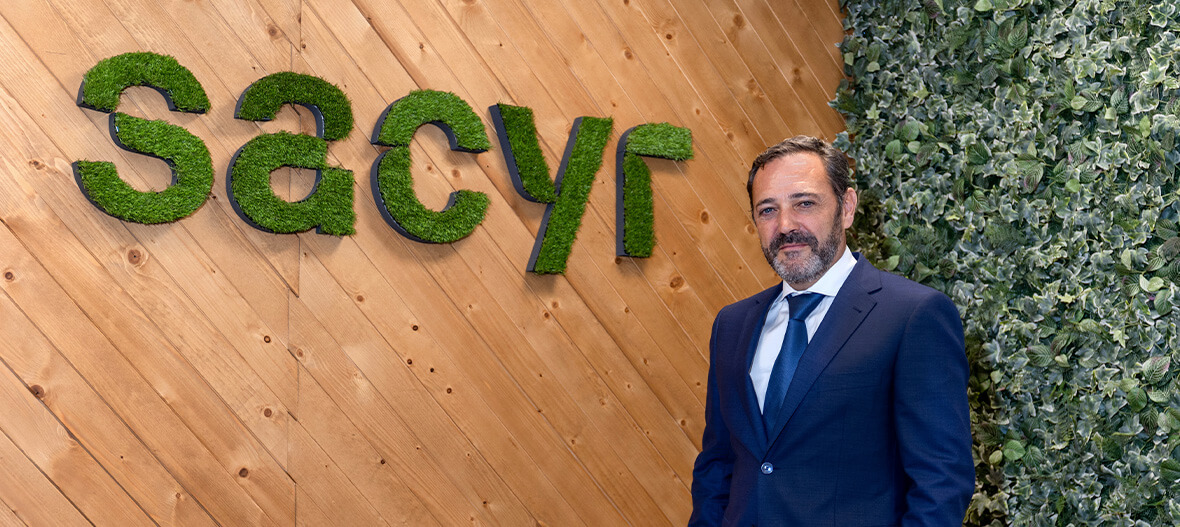The construction giant facing the new digitisation era
Sociedad Anónima de Caminos y Regadíos (Sacyr), was founded in 1986. 36 years later, this Madrid-based construction giant closed its last financial year with a turnover of more than 4.6 billion euros. It has more than 42,000 employees, and since July of this year is listed on the Ibex 35. Gonzalo, a graduate in computational science from Deusto University, has been the company's CIO since 2017 and is one of Spain’s most promising executives. A devotee of mountain activities, skiing and trekking are two of his great hobbies. His CV includes an ascent of Mont Blanc, and he has his eye on the Himalayas. Prudent, firmly advancing according to very clear objectives, despite his job he craves coverage-free moments. We talked to him about the present of Sacyr and his projects for the future.

You can also listen to this post in audio, press play!
— You joined Sacyr more than five years ago. Which challenges have you taken on since then and how has the company progressed?
Sacyr’s development over the past five years has certainly been extraordinary.
Truly a story of successes, with a focus on improving operating return, on developing the key businesses of concessions, construction and services, on growing our internationalisation and selecting the best talent.
During this period, the function of information technology has faced the challenge of enabling the transformation associated with digitising the processes of the company’s different businesses.
Important milestones have been achieved, such as the launch of the Bambú project, an internal management system that has led to a significant improvement in the effectiveness of our financial processes by implementing a solution based on SAP HANA.
Also the GEOS project, an internal development undertaken in record time which arose with the aim of standardising the management of Sacyr projects through a single system that would ensure integral control and simplify processes through digitisation and automation, already deployed in more than 50 projects in 5 countries.
Technological infrastructures have been modernised, jobs have been optimised, the communications network has been transformed, cybersecurity has been strengthened, a new application development framework has been implemented, facilitating the updating and evolution of multiple applications, user support has been transformed and the remote working environment has been deployed to mitigate the impact of the situation arising from Covid-19 and the company's digital talent has been enhanced and improved.
— Tell us about the Sacyr 2021-2025 Plan and its main focuses.
Sacyr’s strategic plan for 2021-25 reinforces the company’s financial strength, with revenue growth exceeding 20%.
To this end it focuses on the entire value chain of the concession model, including the activities of the concession businesses, engineering and infrastructures and services.
In addition, it considers two aspects of strategic importance: appropriately managing sustainability in the area of people, communities and the environment; and attracting talent, managing diversity and adapting to new realities.
— Which initiatives are you launching in the technology area to support these goals?
The strategic technology plan for the 2021-25 period is, of course, fully aligned with the company's strategic plan. It groups all planned initiatives together into six distinct categories:
- Advanced digitisation of business operations to enable the launch of better applications and technological services. The use of appropriate technologies will be key to improving the sustainability of Sacyr’s business activities, which will facilitate the reduction of one third of the carbon emissions required by 2030.
- Optimising the management of critical data, which are key to the group's decision-making processes.
- Extended cybersecurity to minimise risks and ensure the continuity of our activities.
- Optimising the user environment, enabling ever higher levels of use of multiple devices in different locations.
- Efficient management of technological infrastructures, ensuring contingency and recovery.
- Improving the internal management model by optimising the efficiency of expenditure and investment in digital technology.
— An example of a project where technology has been relevant in achieving a strategic company challenge?
Overall, all the efficiency gains resulting from digitisation have been a strategic challenge that, as the actual strategic plan confirms, has been met in the 2015-20 period.
Specifically, it is important to highlight the contribution to internationalisation by transforming and improving the entire technological infrastructure involving servers, storage, and the communications network and jobs, which has enabled the development of strategic projects for Sacyr in very different and distant places of the world.
“… two aspects of strategic importance: appropriately managing sustainability in the area of people, communities and the environment; and attracting talent, managing diversity and adapting to new realities”.
5 CONTINENTS 20 COUNTRIES
Sacyr operates in nearly 20 countries around the world: Algeria, Australia, Brazil, Canada, Chile, Colombia, Ireland, Italy, Mexico, Oman, Paraguay, Peru, Portugal, Qatar, Spain, Sweden, UK, USA and Uruguay.
— Sacyr is a company that uses technology to innovate. What is it like to innovate in a company of these characteristics? What is the investment allocated to innovation?
Sacyr understands innovation as a generator of competitive advantages that helps in dealing with the challenges of today's business while exploring and preparing the organisation to leverage the opportunities that the future will bring.
In this regard, collaboration with business is essential and technology is the great ally in meeting those challenges. Our innovation strategy is based on an open model that allows us to collaborate with the best talent from inside and outside the organisation (start-ups, technology centres, universities, other corporations…).
The aim is to implement pilot projects in real-world environments that allow us to develop or adapt and test the validity of the technology, scaling it up if it is successful. Initiatives incorporating IoT, big data, artificial intelligence… into projects that Sacyr is executing in Colombia, Chile or Portugal.
During the period of the strategic plan (2021-2025) we are committed to doubling investment in innovation and to contributing a significant percentage to improving our sustainability performance, another of the company's priorities.
— Keeping yourselves in a state of constant evolution is one of your maxims, a point in which the team, the people and change management are essential. How are you dealing with this challenge?
We have established a plan to strengthen and acquire digital competencies, focusing on technical versatility, collaboration and willingness to innovate.
We also enhanced the PMO area in the sphere of Digital Technology Governance, with additional resources to coordinate and optimise project development and all associated change management activities.
— The construction sector has not ceased to reinvent itself in recent years. Which are the challenges facing the industry? What will be Sacyr’s role on this journey?
Sacyr will undoubtedly continue in the group of industry leaders and respond to the challenges of ongoing optimisation of operational efficiency; of recovering from risks and unforeseen events, as demonstrated in the response to the situation arising from Covid-19; speeding up our response to customer demand and the complexity of projects; and differentiating between customers by providing a greater degree of value to customer needs.
Why are companies failing to implement business agility?
NEXT ARTICLE

